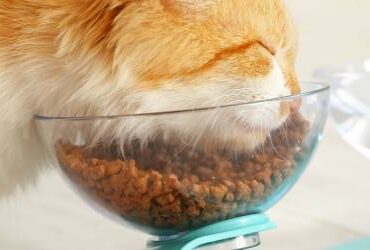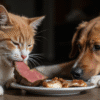
The Shoulds of Cat Parenthood
Hi everyone, and thank you for joining me on this edition of Val Talk’s Pets. Everyone is familiar with the adage, “Coulda, Shoulda, Woulda”. So I thought I would discuss the […]
 play_arrow
play_arrow“Human” Foods For Pets Val Cairney

 play_arrow
play_arrowRegarding Cat Nutrition Val Cairney

Hi everyone and thanks for joining me on this episode of Val Talk’s Pets. In this episode, I’d like to do a bit of an overview regarding cat nutrition. I find that many pet parents are quite confused about what their cat requires and do not require. So, let’s see if I can demystify things a bit.
To begin, cats are carnivores. They fall into the category of obligate carnivores. So, let’s just define what these titles mean. As defined by naturalpetfood.com, “A carnivore is an animal that thrives on a meat-based diet, while an obligate carnivore requires a meat-based diet to survive. Carnivores may eat other sources of nutrients, such as plants and fungi. Obligate carnivores are unable to get the nutrients they need from plants and fungi.”
So, this does beg the question of whether cat food needs to have grain or any other carbohydrate. One very popular brand of food listed in its ingredients is chicken by-product meal, corn, corn gluten, wheat, wheat gluten, beet pulp and vitamins. Hmm? That doesn’t sound like an obligate carnivore’s diet. What’s with the corn and wheat? I don’t think I have ever seen a cat chowing down on an ear of corn.

A cat in the wild would get grains in their diet by eating prey that had eaten grain. So, this is normal. But, the cat’s main purpose is to eat the meat. If this is the case, why are there grains in many cat foods? Well, the somewhat short answer is that some grains can provide certain nutrients, like iron, calcium, B Vitamins, etc. Sometimes you will see that there are complex carbohydrates and or grains in weight control formulas. In this case, the carbs are used to help allow the cat to feel full while reducing calories.
Can this work? Sometimes. But, here’s an example that I experienced with my work cat.
My work cat started to gain weight when she turned about 5 years old. There hadn’t been any specific changes to her diet, she just started to put weight. It was an upsetting time because people would say terrible things about her weight.
It wasn’t enough that an inappropriate thing was said, like, “Wow, isn’t she fat? Is she pregnant? Or “She sure likes her food, but they wanted this weird validation of the comment. After saying, isn’t she fat, they would want this confirmation, saying, she’s fat, isn’t she fat, don’t you think she’s fat? We found this so upsetting and I would try to ignore the comment, but some would just keep hammering for an answer, but I would just say, she’s fine. What I wanted to say was, have you looked in a mirror lately? Did I say that out loud?
Anyway, I took her to the vet and yes, he felt she needed to lose about five pounds. On a cat, that is a lot. We discussed options and he wanted her to go on a prescription weight loss kibble. I was not really on board and even said, yes, she’ll probably lose weight, but that’s because that formula has nothing in it. She might as well eat dust. He disagreed and I said, okay, we’ll try your way for a full bag, but not the one from the vet. He gave me the nutritional levels she would need, and I matched it as closely as possible, and the vet was fine with that.

Now, I can say our cat, loved the food. We measured out the allotment that she could have over 24 hours and doled it out throughout the day bits at a time, so she would always feel that food was there and not deprived. We stuck to this. Did she lose weight? Not an ounce! The vet was surprised. I said, okay, now we do it my way.
My way was to put her on a high protein formula, no grains and see how my little obligate carnivore does.
She lost a pound and a half in about 2 weeks and then a little bit more and then a little more. She didn’t lose the whole 5 pounds in a month, but she did about 3 and a half. Now, the food she was originally on was grain-free, but the key to getting her weight down was the high protein. So, does this little example mean that cats do need a high protein diet and the grains can be ditched?
Well, according to wagwalking.com, grains should be given in moderation and “cats should still get 90% of their calories from a completely balanced cat food.” If you look, however, at brands that specifically always use grains in their formulas, you will see statements like, “Vegetables and grains are low phosphorus sources of essential amino acids that cats need.” (www.hillspets.com). However, according to redbarn.com, “cats can get all the essential amino acids they need from meat.”
Well, that’s another hmm? Petmd.com points out, “Unlike dogs, which are omnivores, cats are obligate carnivores. This means that their bodies have adapted to a diet consisting strictly of meat, which provides animal protein. A cat’s metabolism is especially suited to a strictly meat-based diet.
While herbivores and omnivores can synthesize certain amino acids, which are the building blocks of proteins, cats have a more limited ability to do so. As a result, cats evolved to ingest specific amino acids that already exist in meat sources because their bodies do not produce enough of them for survival. Cats depend on their diet for many amino acids.” Now isn’t that interesting? To me, I’ve never understood why cat food would have rice, corn or wheat when the cat is a carnivore. Stray cats, feral cats, survive quite well on hunting, and there isn’t a grain in sight unless they ingest the grain that the prey ingested.

I have specifically asked the question about corn in a specific high-end brand of cat food when speaking with the brand’s representative. The answer I got was that corn provides additional value to the protein. Really? And what value is that? Corn is a high glycemic grain and we can never know the quality of the corn being used. Check out my episode on demystifying fillers to learn about that. And again, what cat have you seen enjoying an ear of corn? The bottom line is, I didn’t buy that explanation.
So, what is the best approach with cats to make sure they are eating a balanced diet and their weight is healthy? Well, like everything there isn’t any one specific answer. We know that cats are strict meat eaters. We know that they do not produce enough taurine, the amino acid required for eye and heart health, in amounts their bodies need. Taurine is gained from animal-based protein. Therefore, higher amounts of animal protein in a cat’s diet are considered quite essential.
Arguments are often thrown out that cats derive other essential amino acids from grains, but we have to remember that these are often stated by brands that exclusively include grains in their formulas. Pet MD makes it clear that a cat can get all the amino acids required from their meat source. Therefore, it would stand to reason that a high protein, grain-free diet would be the best direction.
Consider, for example, the pet parents that feed raw to their cats. In the raw formulas, the cat-specific choices are pure meat and organ meats, no grains, and no vegetables. The rise of raw feeders shows that many cat parents feel that this diet addresses the cat’s need for meat and their ancestral and prey-driven diet.
For me, I’m going to side on the true obligate carnivore side, meat first and foremost. I just don’t get why an obligate carnivore needs to have rice, corn or wheat. My Rory is working his bum off right now catching mice that are getting into the house. We live in the country, so that’s a given. Most times, we can get the mouse he catches and release it, but sometimes he has a little snack on it and spoiler, this is a bit gross: he eats their heads. To me, that’s one major display of a prey-driven obligate carnivore.
When it comes to figuring out the best approach for your cat’s nutrition, think about some of these points, and of course, one of the most important things to consider is what your cat will eat. That in and of itself can be a challenge. But think about the actual genetics of your cat and try some different things. And, of course, do some research because, as I say, knowing is caring.

Tagged as: nutritional needs of cats, nutrition for cats, cat nutrition tips, Pet Nutrition, cat nutrition, feline nutrition, cat nutrition guide, basic nutrition for cats, cat nutritional needs.
Hi everyone, and welcome to Val Talk’s Pets, the forum for pet parents and enthusiasts alike. So, I have been working in the pet industry now for almost 10 years and, on a daily basis, I handle a lot of issues and questions arising from pet parents. I am not a veterinarian but I do have certifications in Canine, Feline, Small Animal, Fish and Herptile and Avian Health and Nutrition from the University of California, Davis Extension, the Vet College.

Val Cairney October 4, 2024
Hi everyone, and thank you for joining me on this edition of Val Talk’s Pets. Everyone is familiar with the adage, “Coulda, Shoulda, Woulda”. So I thought I would discuss the […]

Val Cairney March 28, 2025

Val Cairney February 28, 2025
For the price of a coffee, or more if you are feeling generous, you can help keep this podcast going & growing. Please visit my ko-fi page to make a donation. Thanks!
all rights reserved - Val Talks Pets - 2024